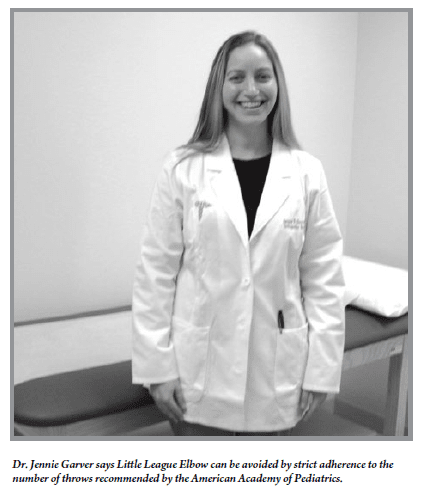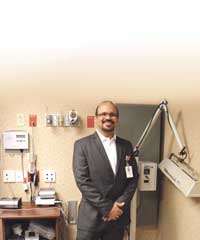Stressful Swings – Overuse and Imbalances Can Often Lead to Elbow Injuries
It was a long, cold winter, and many people are eager to get out on the tennis courts, golf course or ball fields to resume playing the sports they enjoy. But orthopedic surgeons and sports medicine physicians say elbow injuries often occur when people assume they can return to whatever they were doing last summer without some advance preparation.
In fact, Dr. Julio Martinez-Silvestri says what he calls the “terrible toos” — or doing “too much, too fast, too soon” — can lead to elbow problems.
“Many people haven’t done anything for four months, and their joints, ligaments, tendons, and muscles are not prepared to receive the stress forces put on them if they do too much, too quickly,” said the sports medicine specialist and medical director of Baystate Physical Medicine and Rehabilitation. “They need to ease into activity gradually, but instead of going to the driving range and hitting a bucket of balls, some begin their season by playing on a golf course for four hours.”
He added that similar scenarios occur on the tennis court and on baseball fields, especially when children exceed the number of throws the American Academy of Pediatrics has determined to be safe.
Dr. Jennie Garver agrees.
“As soon as it gets warm people want to be outside engaging in activities, but if they introduce a new stressor to the body it may not be able to handle it, especially if they go full force without acclimating the body to the motions most important to their sport,” said the surgeon from the Orthopedic Care Center in Springfield. “It’s also important for people to make sure they are using proper technique because otherwise they may put too much force on the elbow.”
Dr. Sherri Kuchinskas told HCN that 90{06cf2b9696b159f874511d23dbc893eb1ac83014175ed30550cfff22781411e5} of elbow injuries are caused by repetitive stress and fall into the category of tendonitis.

“Golfer’s elbow affects the inside tendon while tennis elbow affects the outside tendon,” said the physician from Cooley Dickinson Medical Group Orthopedics & Sports Medicine. “If you have been fairly sedentary and start playing tennis three to four days a week, the tendon is likely to complain.” Tendons are flexible bands of fibrous tissue that connect muscles to bones and the suffix “itis” refers to inflammation.
Garver agreed that people shouldn’t play 18 holes of golf or several sets of tennis the first time they head out for the season. “They need to build up to it and make sure they do exercises to increase their range of motion,” she cautioned, adding that baseball pitchers with sore shoulders may alter the mechanics of their pitch, which increases the force on the elbow.
“If they’re sore and try to accommodate the discomfort, they can get into trouble,” she told HCN.
In addition, it’s important for people to make sure they are outfitted with the proper equipment, which can be done by checking with a pro who can determine if a golf club or racquet is the right size and is being used correctly. “The pro can also recommend exercises to help you stretch and strengthen your grip,” Martinez-Silvestri said.
He explained that tennis elbow can result from too forceful of a grip, and once the tendon becomes inflamed, even lifting the phone or a book can make the symptoms worse. “It’s a classic overuse injury that can result from hitting the ball at low intensity numerous times or even once at high intensity,” he continued, adding that the injury is also seen with carpenters who hammer constantly and with force.
Kuchinskas agrees that if a tennis racquet is strung too tight, a golf club is squeezed too hard, or the person uses other bad mechanics that overload the elbow, they are apt to be injured. “Your racquet may be too large or too small, so make sure it is the right fit,” she cautioned. “And always warm up and stretch as cold muscles are more prone to injury.”
Prevention and Treatment
The elbow accounts for most of the arm’s versatility. There are three main ligaments that support it, and a large number of muscles that cross the joint and allow it to flex, extend, supinate, and pronate. But they all originate at the elbow, and tendonitis occurs when the ligaments are overused.
“The bicep and forearm muscles attach to the elbow and can also get strained,” Kuchinskas said.
According to the National Institute of Arthritis and Musculoskeletal and Skin Diseases, tendonitis can be prevented by:
• Beginning new activities or exercise regimens slowly;
• Gradually increasing physical demands following several well-tolerated exercise sessions;
• Strengthening muscles around the joint;
• Taking breaks from repetitive tasks often;
• Stopping activities that cause pain;
• Cushioning the affected joint by increasing the gripping surface of tools with gloves or padding or applying grip tape or an oversized grip to golf clubs; and
• Using two hands to hold heavy tools and using a two-handed backhand in tennis.
Kuchinskas says people ages 40 to 60 are especially prone to injury due to wear and tear on the tendon, which is subjected to stress over long periods of time, making it more susceptible to injury.
“There can be a very mild onset, which causes some discomfort, then pain can become fairly consistent and be felt when doing things such as using a remote control or opening a doorknob,” she told HCN.
But injuries can occur at any age, and Garver sees many patients in their 30s and 40s with elbow injuries. “As people get older, their tissues are less pliable so staying in shape is important,” she said.
When pain becomes persistent, activity should be stopped immediately and the formula RICE, an acronym for a combination of rest, ice, compression, and elevation should be used. Kuchinskas suggests applying ice to the elbow for about 20 minutes a few times a day, keeping it elevated above the heart, and using a compression sleeve or counterforce brace during activity. “Advil or Aleve can also help with the symptoms,” she said.
But icing can be tricky. “You have to be careful because there is a big nerve inside the elbow,” Martinez-Silvestri said. “If you start experiencing numbness, you may be icing too much. And if the pain persists for a few days or a week or gets worse and there is swelling, redness and tingling, it may be appropriate to seek medical attention.
In most cases, RICE works, but if the pain is severe enough, physical therapy or cortisone injections may be needed. “But they are not a cure. They are simply a tool to reduce pain so the patient can engage in a rehabilitation program,” Martinez-Silvestri explained, adding if the pain subsides, then returns with activity, it’s a sign that people need to stop.
“People should rest until their symptoms decrease and may have to modify their activity; play once a week or ease their way back into it,” Kuchinskas advised.
Throwing Injuries
The condition known as ‘Little League Elbow’ is typically seen in youths between the ages of 10 to 16. It tends to be significant, is usually accompanied by pain and swelling, and typically happens when the young athlete is learning a new pitch and exceeds the allotment of throws recommended by the American Academy of Pediatrics.
“Their ligaments tend to be stronger than their growth plates,” Martinez-Silvestri said, explaining that even if a child doesn’t complain, the injury can be recognized by a loss of speed or control when the child throws the ball.
“The inside of the elbow is stressed, while the outside is compressed and there can be microtraumas that occur over and over,” Kuchinskas said. “The open growth plates are not entirely fused, so it’s important to stick to a very structured regimen of throwing.”
Although it’s rare, if the bone is continuously compressed, it can become injured, and a much more significant problem can occur. “So, if a young player is complaining about their elbow, it’s a real problem and you need to seek medical help,” Kuchinskas said.
She added that the stress on the joint is exacerbated by the fact that many young people play the same sport year-round and use the same muscles and motions repeatedly.
“I tell parents to switch things up and have their children play different sports during different seasons where they use their legs more,” she noted.
Garver agrees, and adds that parents often urge their children to “play hard” and push through pain. “But you need to listen to your child and let them listen to their body. Pain is not normal and shouldn’t be overlooked,” she said.
The guidelines for the number of recommended throws can be found at www.pitchsmart.org and should be adhered to avoid elbow injuries in young people.
Throwing injuries can also occur in adults and often affect baseball pitchers. They are often referred to as “Tommy John” injuries and require surgery.
“Some people believe the surgery will make them better players or throwers, so they have it done to prevent injury,” Martinez-Silvestri said. “But the reality is that 50{06cf2b9696b159f874511d23dbc893eb1ac83014175ed30550cfff22781411e5} of athletes who have the procedure done will be reinjured and only two-thirds are able to return to throwing on a regular basis.”
The surgery is medically known as ulnar collateral ligament reconstruction, a graft procedure in which the ulnar collateral ligament in the medial elbow is replaced with a tendon from elsewhere in the body. It’s commonly performed on college and professional athletes in several sports, especially baseball.
Plan Ahead
Martinez-Silvestri says almost all elbow injuries can be prevented if people ease into their sport slowly, pay attention to their form, are fitted with the right equipment, and warm up, stretch, and cool down before and after play.
“If you’ve been sedentary, ease into playing your sport; Don’t go from zero to 100,” Kuchinskas said. “Be aware of your body and if you start developing pain that persists see a sports medicine specialist who can help you get back to playing without pain.”
Garver agrees. “I can’t stress enough how important it is to ease into athletics. Hit a tennis ball against a wall for a few days in a row to get your body used to the motion before you start playing matches.
If you’re a baseball player, play a couple of games of toss and don’t throw full force right away. And golfers should begin at the driving range,” she went on. “If you have any pain, stop immediately because it can take an elbow four to six weeks to heal if you overdo it.”


